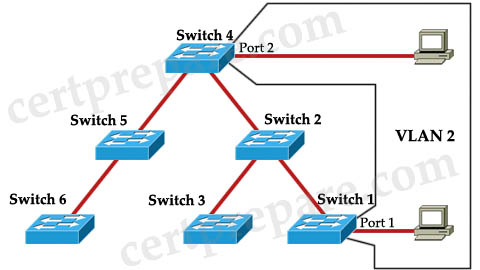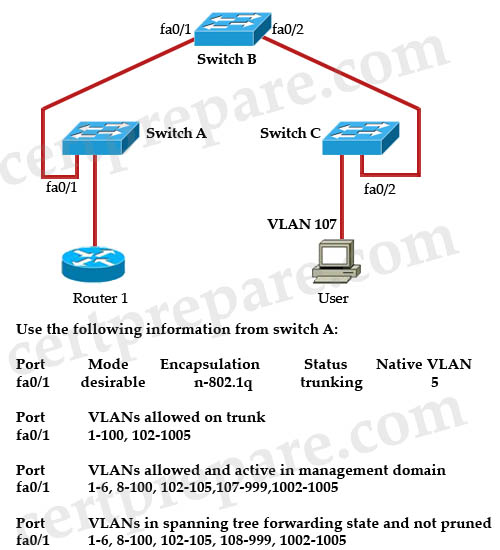VTP Questions 2
Here you will find answers to VTP Questions – Part 2
Question 1
What action should a network administrator take to enable VTP pruning on an entire management domain?
A. Enable VTP pruning on any switch in the management domain.
B. Enable VTP pruning on any client switch in the management domain.
C. Enable VTP pruning on a VTP server in the management domain.
D. Enable VTP pruning on every switch in the management domain.
E. Disable VTP pruning on a VTP server in the management domain.
Answer: C
Explanation
VTP pruning should only be enabled on VTP servers, all the clients in the VTP domain will automatically enable VTP pruning -> C is correct.
Question 2
What must be configured on a Cisco switch in order to advertise VLAN information?
A. VTP mode
B. VTP password
C. VTP revision number
D. VTP pruning
E. VTP domain name
Answer: E
Explanation
A Cisco switch needs a VTP domain name to advertise VLAN information to other switches and it must be configured on a Cisco switch.
Note: If a switch is configured as a VTP server without a VTP domain name, you cannot configure a VLAN on the switch
Question 3
Refer to the exhibit. VTP has been enabled on the trunk links between all switches within the Certprepare domain. An administrator has recently enabled VTP pruning. Port 1 on Switch 1 and port 2 on Switch 4 are assigned to VLAN 2. A broadcast is sent from the host connected to Switch 1. Where will the broadcast propagate?

A. Every switch in the network receives the broadcast and will forward it out all ports.
B. Every switch in the network receives the broadcast, but only Switch 4 will forward it out port 2.
C. Switches 1, 2, and 4 will receive the broadcast, but only Switch 4 will forward it out port 2.
D. Only Switch 4 will receive the broadcast and will forward it out port 2.
Answer: C
Explanation
With VTP pruning enabled network-wide, switch 2 and switch 4 automatically use VTP to learn that none of the switches in the lower-left part of the figure have any ports assigned to VLAN 10. As a result, switch 2 and switch 4 prune VLAN 2 from the trunks connected to these switches. The pruning causes switch 2 and switch 4 to not send frames in VLAN 2 out these trunks -> Switches 3, 5 and 6 will not receive the broadcast while Switch 4 will receive it and forward out to port 2 -> C is correct.
Question 4
Switch R1 is part of the Company VTP domain. What’s true of VTP Pruning within this domain?
A. It does not prune traffic from VLANs that are pruning-ineligible
B. VLAN 1 is always pruning-eligible
C. It will prune traffic from VLANs that are pruning-ineligible
D. VLAN 2 is always pruning-ineligible
Answer: A
Explanation
VLAN 1 and VLANs 1002 to 1005 are always pruning-ineligible; traffic from these VLANs cannot be pruned. Extended-range VLANs (VLAN IDs greater than 1005) are also pruning-ineligible -> A is correct.
Question 5
Switch R1 has been configured with DTP using the desirable option. Which statement describes Dynamic Trunking Protocol (DTP) desirable mode?
A. The interface actively attempts to convert the link to a trunk link.
B. The interface is put into permanent trunking mode but prevented from generating DTP frames.
C. The interface is put into permanent trunking mode and negotiates to convert the link into a trunk link.
D. The interface is put into a passive mode, waiting to convert the link to a trunk link.
Answer: A
Explanation
Note: If an interface is set to switchport mode dynamic desirable, it will actively attempt to convert the link into trunking mode. If the peer port is configured as switchport mode trunk, dynamic desirable, or dynamic auto mode, trunking is negotiated successfully.
Question 6
Refer to the exhibit. What happens when the switch SW2 is connected to the rest of the network in the VTP domain Lab_Network?

A. The recently introduced switch SW2 adds one more VLAN to the VLAN database in the VTP domain.
B. The recently introduced switch SW2 creates a STP loop in the VTP domain.
C. The recently introduced switch SW2 removes all configured VLANs throughout the VTP domain.
D. The recently introduced switch SW2 switches over to VTP transparent mode in order to be included into the VTP domain.
E. A trunk should be configured between the two switches in order to integrate SW2 into the VTP domain.
Answer: C
Explanation
The Configuration Revision number of SW2 is higher than that of SW1 (147 > 47) and SW2 is operating in Client mode so it can send update to other switches. The result is SW1 and other switches in that VTP domain will remove their current VLAN information and copy VLAN information from SW2.
Question 7
What is the default VTP advertisement for subset advertisements in Catalyst switches that are in server or client mode?
A. 30 seconds
B. 5 minutes
C. 1 minute
D. 10 seconds
E. 5 seconds
Answer: B
Explanation
Subset advertisements list the specific changes that have been performed, such as creating or deleting a VLAN, suspending or activating a VLAN, changing the name of a VLAN, and changing a VLAN’s maximum transmission unit (MTU), status of the VLAN, VLAN type (such as Ethernet or Token Ring), length of the VLAN name, VLAN number, security association identifier (SAID) value. Summary advertisements are sent out every 300 seconds (5 minutes) by default.
Question 8
Two Company switches are connected via a trunk using VTP. Which VTP information does a Catalyst switch advertise on its trunk ports when using VTP? (Choose two)
A. STP root status
B. VTP mode
C. Negotiation status
D. Management domain
E. Configuration revision number
Answer: D E
Question 9
The network operations center has received a call stating that users in VLAN 107 are unable to access resources through Router 1. From the information contained in the graphic, what is the cause of this problem?

A. VLAN 107 does not exist on switch A.
B. VTP is pruning VLAN 107.
C. VLAN 107 is not configured on the trunk.
D. Spanning tree is not enabled on VLAN 107.
Answer: B
Explanation
From the “VLANs in spanning tree forwarding state and not pruned” we can deduce that VLAN 107 is currently pruned on switch A.
Question 10
A switch that is to be added to the production network has been preconfigured (trunks, VLANs, VTP, and STP) and was tested in your lab. After installing the switch into the network, the entire network went down. What might explain what happened?
A. The new switch happened to be running Cisco Catalyst operating system, while the other network switches were running Cisco IOS Software.
B. The configuration revision of the new switch was higher than the configuration revision of the production VTP domain.
C. The link costs on the new switch are set to a high value, causing all ports on the new switch to go into a forwarding mode and none into blocking mode, thereby causing a spanning-tree loop.
D. The ports connecting to the two switches have been configured incorrectly. One side has the command switchport mode access and the other switchport mode trunk.
Answer: B
Explanation
If the configuration revision number of the new switch is higher than that of the rest of Cisco switches and it is in Client or Server mode with the same VTP domain then it can wipe out other switches’ VLAN information. This is a nightmare if you are working for a large company and it can make you to lose your job so please remember this: always set your newly added Cisco switch to VTP Transparent mode before plugging into your working network. This step also resets the Configuration Revision Number of that switch back to 0, which is safe to plug into your network.


